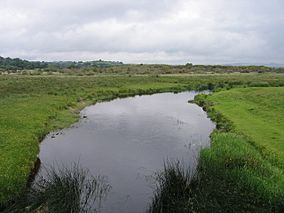Cors Caron facts for kids
Quick facts for kids Cors Caron |
|
|---|---|

River Teifi and Cors Caron from Pont Einon
|
|
| Location | Ceredigion, Wales |
| Governing body | Natural Resources Wales |
Cors Caron is a special type of wetland in Ceredigion, Wales. It's also known as Tregaron Bog because it's close to the small town of Tregaron. This huge area, about 862 acres (3.5 square kilometers), is one of the best examples of a "raised bog" left in the United Kingdom. It's home to about 44 different groups of living things, including plants, fish, insects, and many kinds of birds and mammals.
Contents
A Look Back: How Cors Caron Formed
Cors Caron started forming about 12,000 years ago. This was right after the last ice age ended. A "raised bog" like this grows from a lake or a flat, wet area. Over hundreds of years, mud and peat (partly decayed plant matter) fill up the lake.
Eventually, the peat builds up so high that the center of the wetland no longer gets water from the ground or rivers. It only gets water from rain. Scientists are studying old trees found in the bog. These trees died around 3000 BC and were preserved by the bog's conditions. They help us learn about the climate long ago.
For many centuries, people cut peat from bogs to use as fuel for heating. This practice destroyed many bog ecosystems. Because of global concerns, Cors Caron was made a national nature reserve in 1955.
The bog was once owned by the Trawsgoed Estate. In 1956, the Earl of Lisburne agreed to help manage the reserve. Later, in 1986, the land was sold to the Countryside Council for Wales. Today, Natural Resources Wales looks after Cors Caron. In 1992, Cors Caron was recognized as an important wetland site worldwide under the Ramsar Convention.
What Makes Cors Caron Special?
Cors Caron is mostly made up of bogs, marshes, and wet areas (70%). It also has humid grasslands (21%) and some woodlands (7%). A small part (2%) is made of standing or running water.
Active Raised Bog: A Living Landscape
The most important feature of Cors Caron is its "active raised bog." This means the bog is still growing and forming new peat. It's one of the most complete examples of this type of bog in the UK.
The bog has three main dome-shaped areas. These are separated by the River Teifi. Even though parts were damaged by past drainage and peat cutting, large areas still have healthy bog plants. You can find plants like bog-rosemary and white beak-sedge here.
Bog Woodland: Trees in the Wetland
Cors Caron also has "bog woodland." This is a rare type of forest where scattered trees grow directly on the bog. This happens without harming the bog's special plants. It's different from when trees just take over a bog because of changes in water levels.
The main tree you'll see here is Scots pine. These woodlands are a mix between regular pine forests and open bog areas.
Transition Mires and Quaking Bogs
Another special habitat at Cors Caron is called "transition mires and quaking bogs." These areas are a mix between acidic bogs and more alkaline fens. They have plants that like both acidic and less acidic conditions.
These areas can be very unstable to walk on, which is why they are sometimes called "quaking bogs." It feels like the ground is shaking under your feet!
Depressions on Peat Substrates
You can also find "depressions on peat substrates of the Rhynchosporion." These are open, wet areas, often around the edges of bog pools. They are home to unique plants like white beak-sedge and round-leaved sundew.
These spots are important for rare plants like brown beak-sedge and marsh clubmoss. They often appear in disturbed areas, like old peat-cutting sites or along footpaths.
Amazing Animals at Cors Caron
Primary Species: Otters and Polecats
Cors Caron is a very important home for otters. It's one of the largest wetland areas in Wales and feeds into the River Teifi. This makes it a great place for otters to breed. They also find lots of amphibians to eat in the spring.
The area was also one of the last places in the UK where the European polecat could be found.
Birdlife: A Haven for Birds
Many different birds live at Cors Caron. You might see birds of prey like the buzzard, peregrine falcon, merlin, Eurasian sparrowhawk, and hen harrier. There have even been rare sightings of Montagu's harrier.
The reserve is a safe place for the endangered red kite. This bird of prey was once almost gone, but it has made a big comeback in the area. The wetlands also attract many waterfowl, such as the teal, curlew, and water rail. In drier areas, you might spot snipe, red grouse, tree pipit, grasshopper warbler, and whinchat. The common redstart and willow warbler build their nests in the willow bushes.
Visiting Cors Caron
Cors Caron has good facilities for visitors. There are three car parks, which you can reach from the B4343 road between Tregaron and Pontrhydfendigaid.
You can enjoy a 3-kilometer circular path on a special boardwalk. There's also a 7-kilometer walk along the riverside on a raised path. Next to the reserve, there's a cycle path that uses an old railway track. This path is part of the Ystwyth Trail.
In 2005, work began on a modern bird hide at Cors Caron. It opened in February 2006. This hide is a great spot to watch wildlife, especially birds, up close. The bird hide was built using sustainable materials, like Welsh oak. The £80,000 cost was covered by a European Union program.






